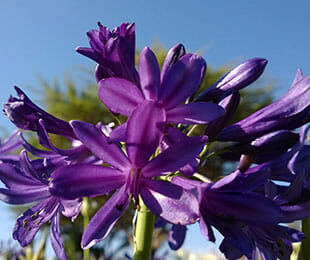Mastering the Art of Agapanthus Treatment: Vital Steps for Healthy Development and Vibrant Blossoms
In the world of cultivation, the farming of agapanthus stands as a gratifying endeavor for those who look for to support these sophisticated blooming plants. From choosing the appropriate selection to understanding trimming strategies, the trip towards cultivating prospering agapanthus plants is diverse and holds the crucial to opening the full potential of these agricultural gems.

Choosing the Right Agapanthus Range

When selecting the ideal Agapanthus variety for your garden, take into consideration aspects such as climate suitability, flower shade, and development behavior. Agapanthus, generally known as Lily of the Nile or African lily, comes in a selection of shades varying from shades of purple and blue to white. Select a bloom color that enhances your existing yard combination to produce an unified landscape. In addition, think about the environment in your area to ensure the Agapanthus selection you pick can grow in your details conditions. Some varieties are more tolerant of chilly temperature levels, while others like warmer climates. Understanding the development routine of different Agapanthus selections is important for appropriate placement within your garden. Some varieties have a clumping growth behavior, ideal for borders or containers, while others have a more spreading nature, suitable for ground cover or mass plantings. By very carefully examining these factors, you can select the ideal Agapanthus selection to boost the beauty of your garden.
Suitable Growing Conditions
Taking into consideration the optimum environmental demands is crucial for successful Agapanthus growing. Agapanthus prospers in well-draining dirt with a somewhat acidic to neutral pH degree. When planting, choose an area that receives complete sunshine to partial color. In hotter environments, offering some mid-day color can prevent scorching of the leaves. Agapanthus plants are delicate to cold temperatures and must be safeguarded from frost throughout winter season.
To make sure healthy and balanced growth and lively blossoms, plant Agapanthus bulbs at a depth of concerning 2-4 inches and space them 8-12 inches apart. Including raw material, such as garden compost, to the dirt can boost drainage and fertility, advertising durable root advancement. Mulching around the base of the plants assists preserve wetness and subdues weed development. Routine watering is important, especially throughout the growing period, to maintain the soil continually moist but not waterlogged.
Watering and Fertilizing Tips
Preserving proper wetness levels and providing essential nutrients are crucial elements in the treatment program for Agapanthus plants. When it comes to watering Agapanthus, it is essential to strike a balance. These plants favor constantly damp soil but are vulnerable to root rot if overwatered.
Fertilizing Agapanthus is necessary for advertising healthy growth and prolific blooms. Apply a balanced fertilizer, such as a 10-10-10 formula, in the early springtime as new development arises. Repeat this application every 6-8 weeks throughout the growing period. Avoid extreme fertilization, as it can result in lush vegetation at the cost of flowers. Always adhere to the maker's guidelines for appropriate dilution and application techniques. By adhering to these watering and fertilizing ideas, you can guarantee your Agapanthus plants flourish and create lively, long-lasting blooms.
Pruning Techniques for Agapanthus
Pruning Agapanthus plants at the suitable times and with appropriate techniques is essential for preserving their health and wellness and advertising optimum development and flowering. The ideal time to prune Agapanthus is in late wintertime or very early spring redirected here before brand-new growth arises.
Deadheading invested flowers can also redirect the plant's energy right into producing even more blooms instead than setting seeds. If you desire to accumulate seeds for breeding, leave some flowers to completely dry and fully grown on the plant.
Bear in mind to make use of tidy, sharp tools to make exact cuts and minimize the threat of presenting illness. Agapanthus. Normal pruning will help keep your Agapanthus looking healthy redirected here and neat while making certain a bountiful display screen of lovely blossoms
Taking Care Of Typical Parasites and Conditions
After making certain correct pruning methods for Agapanthus, it is vital to deal with common bugs and diseases that can influence the wellness and vigor of these plants. One typical insect that influences Agapanthus is the Agapanthus gall midge.
Another typical problem is fungal leaf spot, which offers as dark lesions on the leaves. To stop fungal illness, guarantee great air circulation around the plants, avoid overhanging watering, and remove any contaminated leaves immediately. Furthermore, Agapanthus plants can experience origin rot if they are grown in badly draining pipes dirt. To avoid this, plant Agapanthus in well-draining dirt and stay clear of overwatering. By being watchful and taking punctual activity versus conditions and parasites, you can assist your Agapanthus plants flourish and create vibrant blossoms.

Verdict
To conclude, understanding the art of agapanthus care includes choosing the ideal variety, supplying perfect growing conditions, correct watering and fertilizing, suitable pruning strategies, and attending to usual parasites and diseases. By adhering to these vital actions, you can make certain healthy and balanced growth and vibrant flowers for your agapanthus plants. Bear in mind to on a regular basis monitor and maintain your plants to promote their overall health and durability.
To make certain healthy growth and lively flowers, plant Agapanthus bulbs at a deepness of about 2-4 inches and area them 8-12 inches apart. By complying with these watering company website and fertilizing tips, you can ensure your Agapanthus plants grow and create lively, lasting flowers.
One common insect that influences Agapanthus is the Agapanthus gall midget. In addition, Agapanthus plants can experience from root rot if they are grown in inadequately draining pipes dirt. By following these important steps, you can make certain healthy and balanced growth and vibrant blossoms for your agapanthus plants.